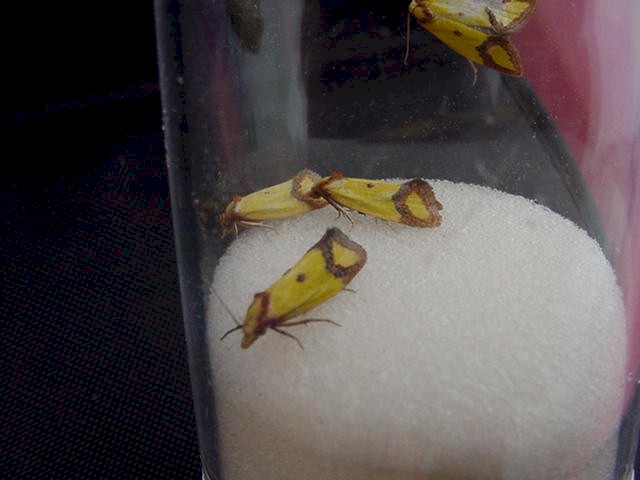Agapeta zoegana
Insect (Lepidoptera: Cochylidae)
Sulphur knapweed moth, yellow-winged knapweed root moth
Photos & Info.: Larvae Adults How to Mass Rear in a knapweed Insectary How to Monitor Release Sites

photo by: Todd Breitenfeldt from the insectaries in Whitehall 7/00
Common names: Sulphur knapweed moth, yellow-winged knapweed root moth. (1)
Origin: Yugoslavia, western Hungary, and eastern Austria. (1)
Life cycle:
Over wintering stage: Larval (1)
Egg stage: Eggs are laid on stems and leaves of the host plant, which is knapweed (usually in the crevices), one or in groups of two or three at a time. When the eggs are laid, they are white in color. But after about three or four days they turn to a yellowish-red color. The eggs hatch after seven to ten days. (1)
Larval stage: The larvae go to the crown area of the host plant (knapweed) where they eat the root. They can move to another root if that root is within 10 centimeters. There are six larval instars.(1)
Pupil stage: The insects then pupate inside the damaged roots or in the soil near the plants. (1)
Adult stage: Usually they become adults during a eight week period including June through August). They grow to be about 11 millimeters long with wings that are yellow with brown markings. Usually mate when temperatures are between 64 and 86o F. The females mate during the first 24 hours of adulthood and lay eggs a day later. Adults live to be 11 days old.(1)
Effect:
Destructive stages: By eating out the roots the larvae damage their host plant (knapweed). The older larvae produce more damage.(1)
Plant species attacked: Spotted knapweed (Centaurea maculosa) and not as often, diffuse knapweed (C. diffusa). (1)
Site of attack: Cortex (middle) of the knapweed roots. (1)
Damage to host: The smaller plants are killed and most of the larger plants do not bloom and/or are stunted. (1)
Releases:
First introduced into the United States: In Montana in 1984. (1)
Now established in: Montana, Washington, and Oregon. (1)
Habitat: Humid, temperate, and have an arid sub continental climate. (1)
Availability: The availability is limited and hard to collect in an open field. (1) Some are available from your Montana County Weed District Coordinators or private biological control companies.
Stage to transfer: Adult and egg. (1)
Redistribution: To collect adults you will need pheromone traps (for males only), black light, a sweep net, or drive them from roots. (1)
Comments: These insects destroy the roots directly which kill the knapweed plant keeping the population of this noxious weed down. If there are no other insects that feed on this plant this particular insect would be very successful in managing the knapweed. In 1994 in Utah this moth was released as an experiment on squarrose knapweed. (1) We are having some success rearing and establishing these in the Whitehall, MT area. See: The Whitehall Project.
Links:
1) http://www.nysaes.cornell.edu/ent/biocontrol/weedfeeders/agapeta.html
2) http://mtwow.org/biological-control-knapweed-monitoring.htm
3) http://www.marathonbiological.com/zoegana.htm
4) http://ceris.purdue.edu/napis/bio/agzo/
5) http://www.forestryimages.org/browse/subimages.cfm?sub=3126
6) http://www.nal.usda.gov/ttic/tektran/data/000012/67/0000126772.html
7) http://www.montana.edu/wwwpb/ag/knapweed.html
8) http://plant.cdfa.ca.gov/biocontrol/annuals/2000annual/2000-33-ce...
9) http://www.for.gov.bc.ca/hfp/noxious/agapeta.htm
10) http://www.ag.state.co.us/DPI/insectary/knapweed.html
Bibliography:
1) Rees, Normanl, et. al., Ed., Biological Control of Weeds in the West, Western Society of Weeds Science, in Cooperation With USDA ARS, Mt Department of Ag, and MT State Univ., Color World Printers, Bozeman Mt, Feb., 1996.
By: Sandra Doris, Carolyn McKinney, and Kaycee Howser, 02/03.
Back to Biocontrol Agents, By Weed mtwow.org HOME
knapweed insectary How to Monitor Release Sites